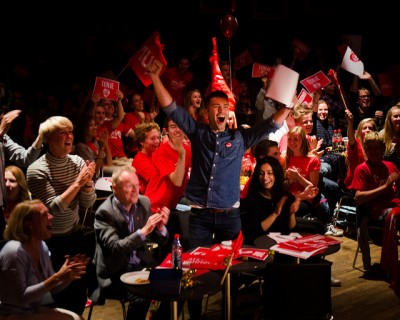Norwegian Labour Party members were cheering loudly Tuesday night after their youth party trounced all others in the country’s important elections held at 400 high schools around the country this week. The school elections are viewed as a key indicator of how the country will vote in the actual mid-term elections on Monday, and Labour performed better than it ever has before.

Never has Labour’s youth party AUF logged such a large percentage of the vote, with its 31.9 percent more than double that of the Young Conservatives, which emerged as second-biggest but with just 16.4 percent of the vote. That’s down from the 28.2 percent the Young Conservatives commanded in the last school elections held in advance of the national elections in 2013.
That was when the Conservative Party won government power away from Labour, which won only 23 percent in the school elections held two years ago. Now the tables have turned, at least among young voters.
“We had hoped for an improvement, but it’s overwhelming that we’ve scored the best school election victory ever,” exclaimed AUF leader Mani Hussaini. “This is a real shot of energy heading into the actual election.”
Progress Party battered
It also suggests that it’s costly to actually hold government power, with the youth groups for both the Conservatives and its minority coalition partner, the Progress Party, losing badly in the school elections. While the Conservatives lost nearly 42 percent of their support from 2013, the Progress Party claimed only 10.5 percent of the vote, down from 15.3 percent two years ago.
The Progress Party has been battered in recent weeks, with election analysts linking their poor showing in the school elections and in recent public opinion polls to its unpopular hard-line response to the ongoing refugee crisis in Europe, which has now reached Norway as well. Progress Party leader Siv Jensen, who also serves as Norway’s finance minister at present, opened the election campaign by suggesting that local governments can and perhaps should refuse to accommodate refugees, while her predecessor, Carl I Hagen, suggested that refugee boats in the Mediterranean should be turned away, and he also criticized all the grass roots efforts to help arriving refugees that have been emerging around Norway. That “shocked the Norwegian people,” according to newspaper Dagsavisen, while other commentators have claimed that the Progress Party has shown itself to be out of touch with public sentiment.
Greens blossom
Labour wasn’t the only youth party setting a record, with the Greens also winning 6.7 per the vote on Tuesday after virtually coming out of nowhere before the last elections in 2013. That result won them a solitary seat in Parliament but now they’ve doubled their support for their environmental and climate measures aimed at halting global warming. No other single party in Norway has come close to gaining so much support so quickly as the Greens, albeit at the expense of other environmentally oriented parties. The Socialist Left (SV)’s youth organization won 7.5 percent of the school vote, however, up from just 5 percent in 2013, while the Liberals’ youth party won 6.5 percent, down from 6.7 percent in the last election.
In other school election results, the Christian Democrats won 3.2 percent of the youth vote, the Center Party won 5.5 percent and the Reds won 4.8 percent. All told, the young voters (most of whom are old enough to vote in the actual election early nest week) leaned much father to the left than they did two years ago.
“It’s a bad sign for the parties now in power (both at the national level and in Norway’s largest cities of Oslo and Bergen) that both the Conservatives and the Progress Party have lost support at the same time,” election researcher Johannes Bergh told Dagsavisen. “When both fall, it shows a clear change, with voters moving from right to left.”
newsinenglish.no/Nina Berglund

